LA MUSICA Y SUS VALORES SON IMPORTANTES PARA CONVIVIR
MARIO LAZALDE 3 A
1 .- COLOCA AQUI TU OPINION SOBRE LA MUSICA Y SUS VALORES ABRE LA PESTAÑA PUBLICAR ARTICULO Y PONES COMO TITULO TU NOMBRE COMPLETO Y GRUPO
CREO QUE ES IMPORTANTE COMPARTIR LA BUENA MUSICA A NIVEL MUNDIAL
2 .- Revisa la letra de imagine da clic en donde dice cancion imagine y llena la tabla que esta debajo con los datos que pide
COPIA ESTA TABLA Y PEGALA DESPUES LA LLENAS COMO ACTIVIDAD DEL BLOG Y RETROALIMENTACION
| VERBS | ARTICLES | NOUNS | PRONOUNS |
DESCARGA LA CANCION DE IMAGINE EN LA SECCION DE PODCAST EN LOS REPRODUCTORES DE COLOR NARANJA
Product 1°G
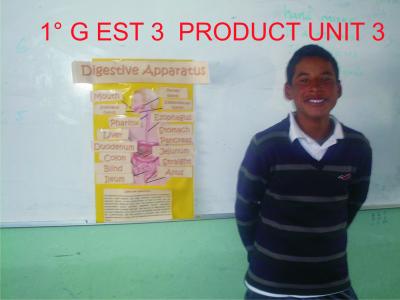
1° F PRODUCT UNIT 3
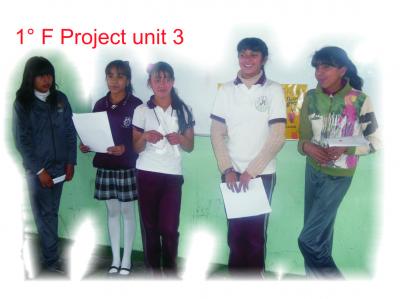
Congratulations
PROJECT UNIT 3 1° G
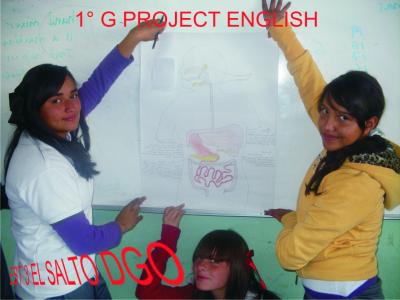
project 1B T.V.
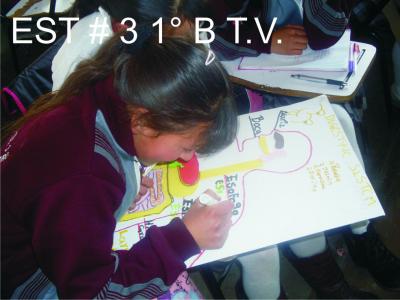
VOCABULARY SYSTEM HUMAN BODY
1. arteries Any of the blood vessels that carry blood away from the heart to all
parts of the body
2. heart The muscular organ inside the chest that pumps blood through the
body
3. blood The red liquid that flows throughout the bodies of humans
4. veins One of the blood vessels through which the blood flows to the heart
from all parts of the body
5. blood vessels Tubes in the body through which blood circulates
6. capillaries Blood vessels that join the end of an artery to the beginning of a vein
7. gallbladder A sac attached to the liver, in which extra bile is stored until needed
8. esophagus The passage for food from the mouth to travel to the stomach
9. large intestine The lower part of the intestine, including the appendix, colon, and
rectum
10. mouth The section of the body containing the tongue and teeth which opens
to allow food to pass through
11. stomach The large organ like a bag or pouch into which food passes from the
mouth and throat to begin the process of digestion
12. liver A large reddish-brown organ in people and animals that helps the
body absorb food
13. pancreas A gland near the stomach that helps digestion
14. small intestine The slender part extending from the stomach to the large intestine that
completes the digestion of food
Human Body
vocabulary Words Week 2
1. skull The bones of the head that surround and protect the brain
2. ribs Narrow bones that curve around the body from the spine in back to the
breastbone in front. Ribs protect the organs inside
3. humerus The long bone of the upper arm that extends from shoulder to elbow
4. vertebrae Bones that form the backbone
5. pelvis A basin-shaped structure in the skeleton
6. ulna The bone on the little finger side of the forearm
7. radius The bone on the thumb side of the forearm
8. carpals The bones of the wrist
9. metacarpals The bones in the hand
10. phalanges Any bone in the fingers or toes
11. femur The long bone of the leg extending from the hip to the knee and
supporting the thigh
12. patella the kneecap
13. tibia The inner and usually larger of the two bones of the vertebrate hind leg
between the knee and the ankle – also called the shinbone
14. fibula The outer and usually smaller of the two bones of the hind limb below
the knee
15. tarsals The small bones in the foot between the metatarsus and the leg – ankle
16. metatarsals The bones in the foot
Human Body
Vocabulary Words Week 3
1. nose A body part on the face just below the eyes, through which air
passes and through which one smells
2. pharynx The space behind the cavity of the mouth into which the nostrils
and esophagus open
3. larynx The upper portion of the windpipe that contain the vocal cords –
voice box
4. trachea The main part of the system of tubes by which air passes to and
from the lungs to make breathing possible
5. bronchial tubes A branch of the windpipe that brings air to and from the lungs –
the windpipe
6. lungs One of the pair od organs for breathing found in the chest. The
lings take in oxygen from the air and remove carbon dioxide from
the blood
7. alveoli Air cells in the lungs
8. respiration The process of taking in oxygen and giving off carbon dioxide
which is breathing
9. exhale To breathe out
10.inhale To breathe air into the lungs
Human Body
Vocabulary Words Week 4
1. involuntary muscle A muscle that works or moves on its own
2. voluntary muscle A muscle that can be controlled
3. joint A place in the body where bones come together and movement can
occur
4. ligament A tough, flexible connecting tissue that attaches one bone to another
bone at a joint
5. nerve Cells along which messages are carried to and from the brain
6. organ Groups of tissues working together
7. reflex An involuntary response not controlled by the brain
8. medulla The smallest part of the brain that controls many involuntary
movements
9. cell The smallest unit of an organism that carries out all activities of life
10.cerebellum The part of the brain that smoothes and coordinates movement
11.cerebrum The part of the brain that controls the ability to think, learn, and talk
12.sensory nerve A nerve that receives messages from inside or outside the body and
sends them to the brain by way of the spinal cord
13.skeleton A hard structure that supports and protects and animal or human’s
body
14.spinal cord A thick, cordlike bundle of nerves along which messages ftravel to
and from the brain
15.tendon A tough, white band of connecting tissue that attaches skeletal
muscle to bone
16.tissue Different cells working together to do the same job
17.oxygen A gas having no color, smell, or taste that humans need to live
18.carbon dioxide A gas made of carbon and oxygen having no color or smell. When
we breathe out, we put carbon dioxide into the air
19.ventricle Either of the two lower chambers of the heart that receive blood
from the auricles and forces it into the artieries
20.atrium The chambers of the heart that receives the blood from the veins
Human Body
Vocabulary Words Week 4
Circulatory System
CARDIOVASCULAR SYSTEM VIDEO
RESPIRATORY SYSTEM
respiratory system
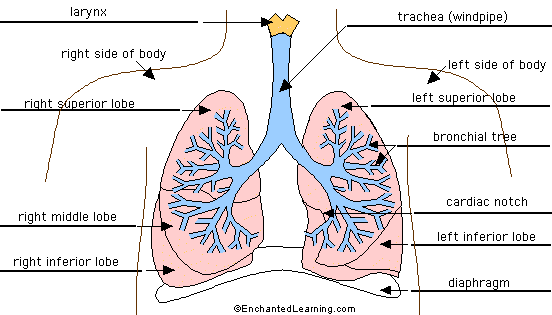
Lung Anatomy |
The lungs are respiratory organs -- we use them to breathe. We breathe in order to get oxygen (O2) and to get rid of carbon dioxide (CO2).
We breathe in through the nose or mouth. The air then goes through the larynx and the trachea (also called the windpipe) and into the lungs. We breathe by using the diaphragm, a muscular membrane under the lungs. When the diaphragm the diaphragm contracts and pulls downwards, the lungs expand and air enters the lungs (inhalation). When the diaphragm relaxes, air is exhaled from the lungs.
When the air is in the lungs, it comes enters capillary-lined alveoli (singular alveolus). In the hollow alveoli, gas exchange occurs [oxygen (O2) is absorbed by blood in the capillaries and carbon dioxide (CO2) is gotten rid of].
People have two lungs -- they are located on either side of the heart within the rib cage. The two lungs are not identical; the right lung has three lobes and the left lung has two lobes.
Lung Glossary
alveoli (singular alveolus) - hollow, capillary-lined structures within the lungs that are the site of gas exchange with the blood [the absorption of oxygen (O2) and the loss of carbon dioxide (CO2)]. Each human lung contains about 300 million alveoli. |
|
Urinary System
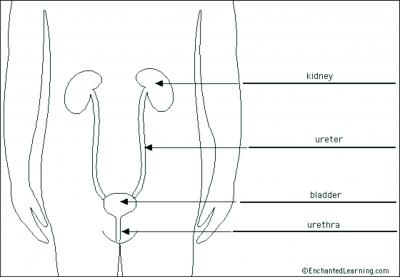
Urinary System |
The urinary tract (also called the excretory system) consists of the parts of the body that makes, stores and excretes urine. Urine contains waste from the blood that must be eliminated from the body.
The urinary tract includes a pair of bean-shaped kidneys (which filter waste from the blood and produce urine), two ureters (tubes through which urine leaves the kidneys and travels to the bladder), a bladder (where urine is stored), and the urethra (the tube that carries urine from the bladder out of the body).
Definitions:
bladder - a hollow organ that stores urine until it is excreted. |
The human digestive system
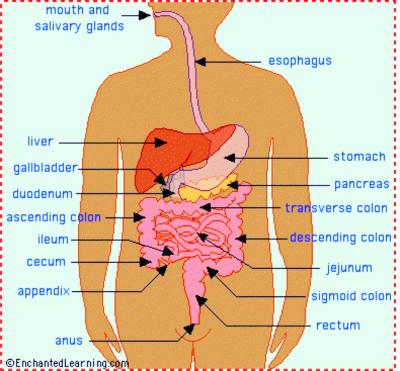
The human digestive system is a complex series of organs and glands that processes food. In order to use the food we eat, our body has to break the food down into smaller molecules that it can process; it also has to excrete waste.
Most of the digestive organs (like the stomach and intestines) are tube-like and contain the food as it makes its way through the body. The digestive system is essentially a long, twisting tube that runs from the mouth to the anus, plus a few other organs (like the liver and pancreas) that produce or store digestive chemicals.
The Digestive Process:
The start of the process - the mouth: The digestive process begins in the mouth. Food is partly broken down by the process of chewing and by the chemical action of salivary enzymes (these enzymes are produced by the salivary glands and break down starches into smaller molecules).
On the way to the stomach: the esophagus - After being chewed and swallowed, the food enters the esophagus. The esophagus is a long tube that runs from the mouth to the stomach. It uses rhythmic, wave-like muscle movements (called peristalsis) to force food from the throat into the stomach. This muscle movement gives us the ability to eat or drink even when we’re upside-down.
In the stomach - The stomach is a large, sack-like organ that churns the food and bathes it in a very strong acid (gastric acid). Food in the stomach that is partly digested and mixed with stomach acids is called chyme.
In the small intestine - After being in the stomach, food enters the duodenum, the first part of the small intestine. It then enters the jejunum and then the ileum (the final part of the small intestine). In the small intestine, bile (produced in the liver and stored in the gall bladder), pancreatic enzymes, and other digestive enzymes produced by the inner wall of the small intestine help in the breakdown of food.
In the large intestine - After passing through the small intestine, food passes into the large intestine. In the large intestine, some of the water and electrolytes (chemicals like sodium) are removed from the food. Many microbes (bacteria like Bacteroides, Lactobacillus acidophilus, Escherichia coli, and Klebsiella) in the large intestine help in the digestion process. The first part of the large intestine is called the cecum (the appendix is connected to the cecum). Food then travels upward in the ascending colon. The food travels across the abdomen in the transverse colon, goes back down the other side of the body in the descending colon, and then through the sigmoid colon.
The end of the process - Solid waste is then stored in the rectum until it is excreted via the anus.
Circulatory System Research Summary
Name: _______________________
Circulatory System Research Summary
Texts:
Biology: Exploring Life: chapter 30.1-30.3
Biology: The Dynamics of Life: chapter 37.2
Hole’s Human Anatomy and Physiology: chapter 15
1. 1 pt. What is the function of the circulatory system?
__________________________________________________________________________________________________________________________________
2. 5 pts. The heart pumps blood through our body. How many chambers does the human heart have? ______ The top chambers that receive blood are called _____________. The bottom chambers that pump blood out of the heart are called _______________.
Which two chambers contract first? ________________ Second? ______________
Fill in the correct chamber of the heart or blood vessel to complete the path of blood through heart, body and lungs.
Superior vena cava and Inferior vena cava à _________________ à right ventricle à __________________ (vessel) à lungs à pulmonary vein à _________________ à __________________ à _____________ (vessel) à body à BACK TO START
3. 4 pt. Identify the three types of blood vessels and complete the chart below:
Name of Blood | Direction of Blood | Thickness of Walls | Presence of valves? |
|
|
|
|
|
|
|
|
|
|
|
|
4. 2 pt. Visit “The Path of an Electrical Signal” at the following website: www.lifebeatonline.com/summer2004/learning.shtml.
In which chamber of the heart is the pacemaker, the SA node, located? ____________
Number each of the events to put them in the correct order:
___ The AV node receives the signal ___ The atria contract
___ The SA node sends out the signal ___ The ventricles contract
5. 3 pt. Relate pulse and blood pressure to contraction of the heart.
An average pulse is between 60 – 100. What does this number mean? ____________
________________________________________________________________
A typical blood pressure is 120/80. What is the top number called? _____________
What does this number represent? ______________________________________
________________________________________________________________
What is the bottom number called? _______________ What does this number represent? _______________________________________________________
6. 4 pt. What are functions of the 4 main components of blood?
- Red blood cells __________________________________________________
- White blood cells ________________________________________________
- Platelets ______________________________________________________
- Plasma ________________________________________________________
7. 4 pt. Choose one of these conditions and complete the questions. Each member of the group will research one condition and complete the questions on this form. As a group, you must complete the questions for ALL of the diseases/conditions.
Some common diseases or conditions of this system are:
- Atherosclerosis
- Heart attack
- Fibrillation
Name of disease: _____________________________________________________
- What are the causes? _____________________________________________
- What are the symptoms? ___________________________________________
- What effects are seen on the circulatory system? ________________________
______________________________________________________________ - How is the condition treated? _______________________________________
________________________________________________________________
2 pts. Sources (minimum of 3 – use a text FIRST, then consult websites, articles, etc.)
Citations MUST be complete – see Media Center Works Cited page. ______________________________________________________________________________________________________________________________________________________________________________________________________________________________________________________________________________________________________________________________________________________________________________________________________________________________________________________________________________